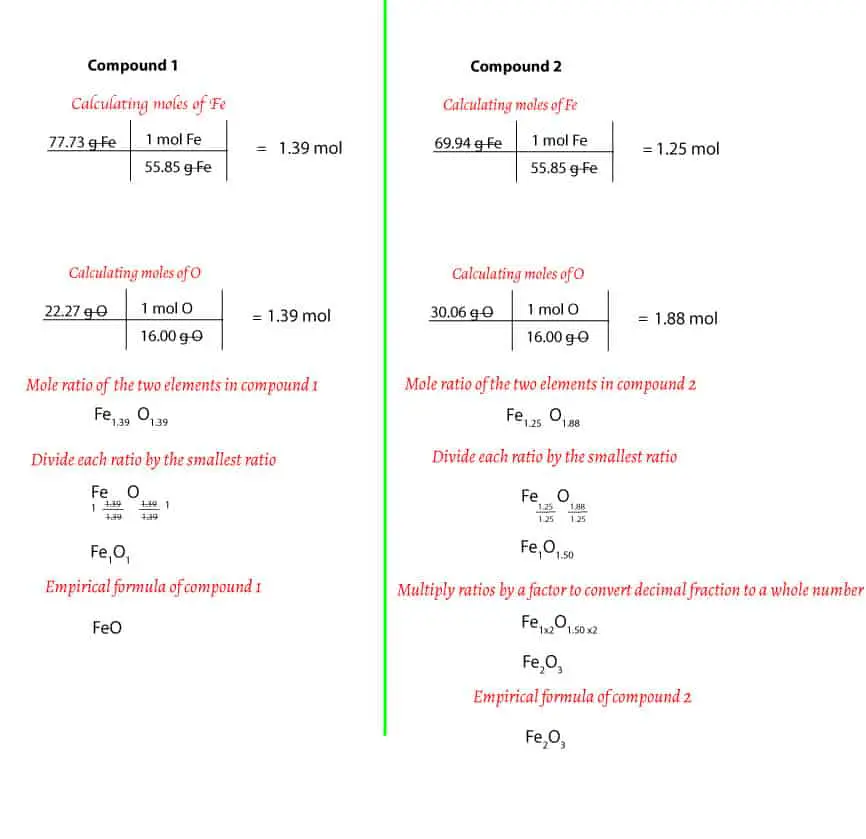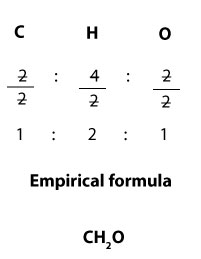How To Find Percent Composition From Molecular Formula
Empirical formula expresses the simplest mole ratio of the elements in a compound or molecule. To determine empirical formula from percentage composition, you must outset convert the percentage composition values to masses. You practise this conversion by assuming that you lot have 100 g of your compound. Go on in heed that this 100.00 grand is just a definition. Next, you then multiply the percentage composition value by the 100.00 thousand. The answer yous get volition exist how much mass the element contributes to the mass of the compound. Go along in mind that you must split each limerick by 100 before yous multiply. Now, permit'south employ the post-obit example to decide the empirical formula from pct composition.
Let's say you carried out an elemental analysis of two compounds that consist of iron and oxygen. From the analysis, you found that one of the compounds consists of 77.73% of Iron, while the other 69.94% of Iron. From the data, determine the empirical formulas of the compounds?
Solution
Step i: calculating the mass of each element in grams
For compound 1, nosotros must presume that we take 100 g of it. Side by side, you must detect the mass of each element in the 100 g of the compound. To do this, yous volition multiply the percentage composition by the 100 g. If you practice, you will get:
77.73/100 * 100 thousand = 77.73 grand Iron
Now, since each compound consists of iron and oxygen, so information technology follows that nosotros can get the mass of oxygen past subtracting the mass of Iron from the mass of the compound (100 g). This is considering if you add the mass of oxygen to the mass of iron, y'all will get the total mass of the compound (police of conservation of mass)
For compound 1, we will practice: 100 g – 77.73 m Fe = 22.27 g O. If you are following, you lot will detect that compound 1 consists of 77.73 g of Fe and 22.27 g of O.
Similarly, for compound 2, we can find the mass of Fe by multiplying the percentage composition past the 100 g. If you exercise, you will get:
69.94/100 * 100 thou = 69.94 chiliad Fe
Also, you tin can find the mass of O by subtracting the mass of Fe from the mass of the compound. If you do, you will go:
100 g – 69.94 g Fe = 30.06 one thousand O
After calculating, you volition detect that compound two consist of 69.94 g of Iron and 30.06 g of O.
Stride 2: converting the mass of each element to moles
Now that nosotros know the mass of each chemical element, the next thing is to calculate the moles of each element. How do we practice this? To summate moles, first, yous must use the periodic tabular array to make up one's mind the molar mass of Iron and O. If y'all do, you volition notice that Fe has a tooth mass of 55.85 g/mol, while O has a molar mass of 16.00 chiliad/mol. Second, y'all must use this molar mass as a conversion gene to catechumen from grams of each element to moles of each element. For compound ane and 2, the conversions volition wait like this:
For compound i,
Moles of Fe: 77.seven g x one mol/55.85 m = 1.39 mol Fe
Moles of O: 22.27 thou x 1 mol/xvi.00 g = ane.39 mol O
For compound 2,
Moles of Fe: 69.94 1000 10 1 mol/55.85 m = 1.25 mol
Moles of O: xxx.06 chiliad x ane mol/16.00g = 1.88 mol O
Step 3: divide the mole ratios by the simplest ratio
For compound 1, the mole ratio of Fe to O are 1.39 to 1.39 respectively. If yous carve up each ratio by i.39, you go 1. Therefore, the mole ratio of Fe and O is i to 1. If we take this ratio into account, then the empirical formula of compound ane is FeO
For chemical compound 2, the mole ratio of Fe to O are one.25 to ane.88 respectively. If you divide each ratio by the lowest, 1.25, yous will get one and i.five respectively. Therefore, the mole ratio of Fe and O is 1: i.5. However, if we take this ratio into account, and so the empirical formula of compound 2 is Iron1O1.v. Only as y'all may recall, atoms do not exist as fractions. Because of this, we must convert i.5 to the nearest whole number. To do this, we must multiply both ratios past 2. If we do, nosotros will become 2 for Fe and 3 for O. Therefore, the empirical formula of compound 2 is: Fe2Othree.
Here is a summary of the higher up calculations:

How to determine empirical formula from molecular formula
Empirical formula expresses the simplest mole ratio of the elements in a compound or molecule. While molecular formula expresses the actual number of each element in a molecule. As y'all tin tell, empirical and molecular formula are related, merely not identical. Usually, you tin derive the molecular formula from the empirical formula by multiplying the mole ratio in the empirical formula by a specific number. In the same way, you can derive the empirical formula from the molecular formula by dividing the mole ratio in the molecular formula by a specific number. Permit's employ the following case to illustrate.
For instance,
if the molecular formula of an organic molecule is C two H 4 O 2, what is its empirical formula?
Solution
Since the molecular formula is CiiHivO2,it follows that the mole ratios of carbon, hydrogen, and oxygen in the formula are 2:4:2 respectively. From these ratios, y'all can see that each of them can be divided past 2 without leaving a residual. Now, since empirical formula expresses the simplest ratio, then information technology follows that we tin can divide the ratios by 2 to get the empirical formula. If we do, nosotros volition become:

Since 1:ii:i is the simplest ratio, we can write the empirical formula as CiH2Oane, which is the same as CH2O. We can get back the molecular formula—C2H4O2— by multiplying the mole ratios in the empirical formula— C1H2O1— by ii.
Mostly, the relationship between empirical and molecular formula can exist expressed as:
- (Empirical formula) due north = molecular formula
Where n can be one,2,three, and and then on
In other words, the above human relationship is the aforementioned thing as saying how many empirical formulas (n) tin go into making the actual chemical compound. Therefore, another style you tin can find n is if you know the tooth mass of the actual compound and the tooth mass of the empirical formula. If you do, yous tin can divide the molar mass of the actual chemical compound by the molar mass of the empirical formula to get the subscript, north. Once you lot get n, you will then multiply the subscripts in the empirical formula by due north to get the molecular formula.
If you desire to learn how to determine empirical formula from combustion analysis, click here.
Source: https://masterconceptsinchemistry.com/index.php/2019/03/07/empirical-formula-what-is-it-and-how-to-find-it-from-percentage-composition-and-molecular-formula/
Posted by: benitohoure1990.blogspot.com


0 Response to "How To Find Percent Composition From Molecular Formula"
Post a Comment